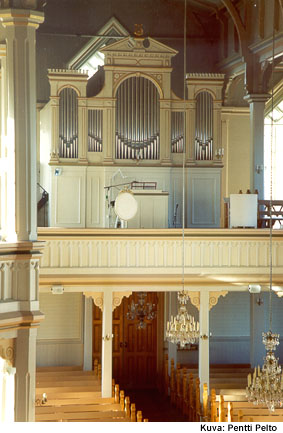|
HISTORICAL ORGANS IN FINLAND 
Merikarvia Church- Thulé, Bror Axel 1900
- 25 stops, 2 manuals and pedal
- pneumatic action and pneumatic stop action
Merikarvia Church, designed by architect Johan Nordstrand, was completed in 1899. It is a large wood cruciform church with a low tower in its centre. The lofts, which almost circle the entire church, are supported by pillars which divide the transepts into three parts, the nave having a peaked ceiling and the aisles having flat ceilings.
Bror Axel Thulé built the large organ in the spacious loft above the main entrance in 1900. The instrument has remained unchanged except for the addition of a blower in 1935. A new pedalboard was built some time ago, but the old one was preserved within the organ. The instrument is valuable because of its quality, its polished construction and its large size.
Appearance
The organ has an in-line structure, with the main division chest in front and the maintenance access space and the Manual II swell box behind it. The Pedal chest is next to the back wall of the case. The large bellows is under the chests. The console is a separate structure in front of the organ.
The high Neo-Classical façade is divided into five sections. The middle arched flat is the largest; it is topped with a pediment with a harp ornament. The outermost flats too are arched, but they are oblong and have a crenellated moulding. The façade pillars have coffered decorations in their lower parts and grooves higher up. The shutters in the lower part of the façade are profiled, but the back and side walls of the case are panelled.
Technical features
The reservoir is a large double rise reservoir under which are two wedge-shaped feeder bellows. Two foot levers are used to operate these, via a rare belt-and-roller mechanism. Each lever rotates a transverse roller above it in different directions by means of belts wound around it. Similar belts pull the feeder bellows upwards. The mechanism is soft and noiseless. The roller ensures that the foot levers operate alternately, and the mechanism is contained in a small space. From the reservoir, the wind progresses to the stop channels of the chests through round channels. Each division has its own concussion bellows.
The chests are of the stop channel type, and each stop channel has its own lid. The narrow key-specific channels here run along the top of the chest, whereas in later instruments they are cut into the bottom plate. The relay at the edge of the chest is constructed so that the relay wire and the leather button at its end act as tuning keys. Bror Axel Thulé apparently only built a few such chests around the turn of the century.
The action is wholly pneumatic, and is driven by the main bellows. The console in front of the organ is turned to face the church. The manual keyboards have celluloid and ebony coverings. The round stop switches, which can be locked in the down position, are above Manual II. The couplings are operated with four foot levers. The switches for the fixed combinations are on the lower rim of Manual I. There are three levels of dynamics for the entire organ and, as a speciality, an independent forte switch that only affects the Pedal.
Musical properties
Due to the pneumatic action, the organ is light to the touch, and couplings do not make the touch any heavier. Because the keys are balanced using springs, there is no mechanical feel at all.
The pipes are made of an alloy containing a high proportion of tin, as was the practice at the time. The upper board of the Manual I Mixtur is almost a metre above the chest. The 8’ Principal of the Pedal is advantageously placed due to its long feet. The placement of pipes on the chest is quite spacious, as is the practice in large Romantic organs.
The disposition is governed by the principles of the last decade of the 19th century. It is noteworthy that there are no high stops apart from the Mixtur. Because of the size of the instrument, there are several characteristic flute stops for a variety of solo and accompaniment functions. The sound of the organ is powerful and penetrating due to the size of the church. The volume was achieved by using high mouths and high wind pressure. The pipes speak freely, and the attack is quick and characteristic. The Posaune, which has wood resonators, is broad and rich in sound. The violin stops are not very shrill, although they are thin and soft. The wide flutes are very rich indeed.
Disposition
Manual I C-f3 | Manual II C-f3 | Pedal C-d1 |
Bordun 16 fot | Gedackt piano 16 fot | Subbas 16 fot |
Liebl.Gedackt 8 fot | Rörflöjt 8 fot | Principal 16 fot |
Hohlflöjt 8 fot | Geigen principal 8 fot | Principal 8 fot |
Fl.harmonique 8 fot | Fl.traversiére 8 fot | Violoncello 8 fot |
Gemshorn 8 fot | Salicional 8 fot | Octava 4 fot |
Gamba 8 fot | Salicet 4 fot | Bassun 16 fot |
Principal 8 fot | Fl.octaviante 4 fot | |
Flöjt 4 fot | P-pal octav 4 fot | |
Octava 4 fot | | |
Mixtur 3 chor | | |
Trompet 8 fot | | |
| | |
| | |
|
|
|
II-I, I-Ped, II-P, I 4’ | | |
mezzoforte, forte, fortissimo | | |
forte for the Pedal | | |
The shutters of the Manual II swell box are | | |
on the front and top of the case. | | |
| | |
| | |
| | |
| | |
| | |
| | |
| | |
| | |
|